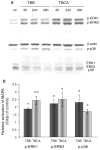Treatment of cultured human astrocytes and vascular endothelial cells with protein kinase CK2 inhibitors induces early changes in cell shape and cytoskeleton
- PMID: 21125314
- PMCID: PMC3426611
- DOI: 10.1007/s11010-010-0667-3
Treatment of cultured human astrocytes and vascular endothelial cells with protein kinase CK2 inhibitors induces early changes in cell shape and cytoskeleton
Abstract
Ubiquitous protein kinase CK2 is a key regulator of cell migration, proliferation and tumor growth. CK2 is abundant in retinal astrocytes, and its inhibition suppresses retinal neovascularization in a mouse retinopathy model. In human astrocytes, CK2 co-distributes with GFAP-containing intermediate filaments, which implies its association with cytoskeleton. Contrary to astrocytes, CK2 is co-localized in microvascular endothelial cells (HBMVEC) with microtubules and actin stress fibers, but not with vimentin-containing intermediate filaments. Specific CK2 inhibitors (TBB, TBI, TBCA and DMAT) and nine novel CK2 inhibiting compounds (TID43, TID46, Quinolone-7, Quinolone-39, FNH28, FNH62, FNH64, FNH68 and FNH74) were tested at 10-200 μM for their ability to induce morphological alterations in cultured human astrocytes (HAST-40), and HBMVEC (For explanation of the inhibitor names, see "Methods" section). CK2 inhibitors caused dramatic changes in shape of cultured cells with effective inhibitor concentrations between 50 and 100 μM. Attached cells retracted, acquired shortened processes, and eventually rounded up and detached. CK2 inhibitor-induced morphological alterations were completely reversible and were not blocked by caspase inhibition. However, longer treatment or higher inhibitor concentration did cause apoptosis. The speed and potency of the CK2 inhibitors effects on cell shape and adhesion were inversely correlated with serum concentration. Western analyses showed that TBB and TBCA elicited a significant (about twofold) increase in the activation of p38 and ERK1/2 MAP kinases that may be involved in cytoskeleton regulation. This novel early biological cell response to CK2 inhibition may underlie the anti-angiogenic effect of CK2 suppression in the retina.
Figures






References
Publication types
MeSH terms
Substances
Grants and funding
LinkOut - more resources
Full Text Sources
Miscellaneous

